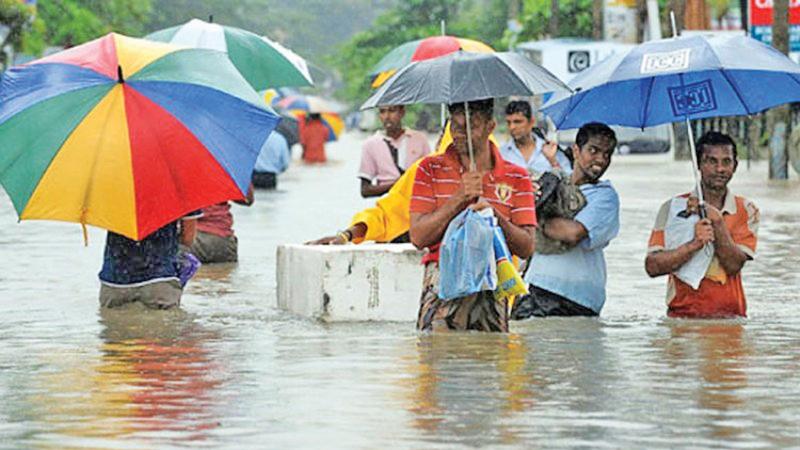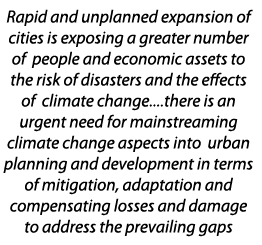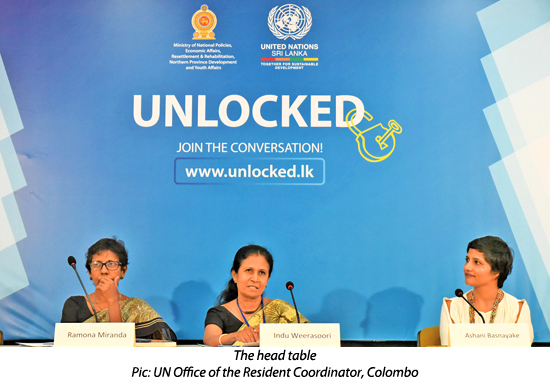
Could urban areas in Sri Lanka stand against the challenge of climate change? The United Nations in Sri Lanka together with the Ministry of National Policies and Economic Affairs, UNLOCKED the key policy development areas in making the country’s urban areas climate resilient, inviting public dialogue early last week.
 Due to tropical climate patterns in Sri Lanka, the island remains highly vulnerable to climate change impacts, with the increasing likelihood of more frequent and intense droughts, floods and other natural disasters. This calls for robust mechanisms, integrating climate change policy into urban planning and development to ensure climate resilience.
Due to tropical climate patterns in Sri Lanka, the island remains highly vulnerable to climate change impacts, with the increasing likelihood of more frequent and intense droughts, floods and other natural disasters. This calls for robust mechanisms, integrating climate change policy into urban planning and development to ensure climate resilience.
According to Project Manager-Urban of UN Habitat, Indu Weerasoori, there is an urgent need for mainstreaming climate change aspects into urban planning and development in terms of mitigation, adaptation and compensating losses and damage to address the prevailing gaps.
“The Sri Lankan Government has identified policies, strategies and action, but these are not mainstreamed into urban policies. We have urban policies, separate climate change policies and the national urban framework, but the problem lies in not integrating these,” Weerasoori said. She was speaking at the Unlocked policy development forum on Climate Change and Urban Resilience held at the United Nations compound on Monday(3).
 She also said overlapping mandates of different Ministries proves inefficient in the process towards integration and implementation of Climate Change policy. It is vital to strengthen the capacity of key institutions responsible for urban planning and development, she said.
She also said overlapping mandates of different Ministries proves inefficient in the process towards integration and implementation of Climate Change policy. It is vital to strengthen the capacity of key institutions responsible for urban planning and development, she said.
Support from Central Government
Climate change poses challenges to environmental sustainability, economical structure, settlement patterns, livelihood and employment, Weerasoori said, quoting from a joint research on ‘Mainstreaming Climate Change into Urban Planning and Policy’ conducted by UN Habitat and Institute of Policy Studies (IPS) Sri Lanka. Cities and urban areas being centres of social activity and economic growth are also hot spots for greenhouse gas emission, while high concentration of human population and built environment renders cities highly vulnerable to the impacts of climate change,”Weerasoori said.
According to the study, neither sufficient climate change resilience nor significant greenhouse gas emission reductions can be achieved without local governments playing a more central role. However, local governments can only meet this need with the support and guidance of central governments, she said.
Disaster management in Sri Lanka is stuck in a cycle of reactivity, where the focus is on mitigation and building back better, although implementation of Disaster Reduction and Resilience (DRR), which can break this cycle, is embedded in the country’s policy and plans, Research Associate, Verite Research, Ashani Basnayake said.
She attributed this to the existence of a gap in the implementation of the Disaster Management Act. Disaster Management Act No. 13 of 2005 was established following the 2004 Tsunami, to ensure future disaster preparedness.
The National Council for Disaster Management (NCDM) and Disaster Management Centre (DMC) were established under the Act.
The NCDM is the supreme body for disaster management in the country, and remains responsible for policy planning and management of disasters, monitoring and oversight, facilitating emergency response, recovery, relief, rehabilitation and reconstruction.
Statutory four sittings
However, by making inquiries under the Right to Information (RTI) Act, Basnayake was able to discover that the NCDM never sat the statutory four sittings per year since its inception.
“The Council met 13 times during the 13-year period from October 2005 to December 2018, which fullfils only 25 per cent of the statutory requirement. The only year it was close to achieving the yearly target was in 2011,where it sat three times during the year,” she said.
Basnayake also said that, key members were notably absent from the meetings and the quorum was satisfied only during five meetings, which has resulted in delays in approving or endorsing key documents and decisions, and in completing key strategic activities. This in turn severely hinders the process of disaster resilience.
The experts also highlighted the importance of redefining the urban areas in the country for a more robust disaster resilience process.
According to the Urban Development Authority (UDA), Sri Lanka has 264 urban areas, including 24 relatively larger urban agglomerates, controlled by municipal councils, 41 urban councils and several smaller townships coming under Pradeshiya Sabhas.
However, one of the key findings of the State of the Sri Lanka Cities Report 2018, was that Sri Lankan cities are larger and are expanding at a faster rate than official statistics suggest.
According to UNDESA, as per Sri Lanka’s official urban population, the country ranks 11th least urbanized on earth, where the rate of urbanisation is less than one per cent per year. “However, our analysis on satellite imagery found that significant hidden urbanisation outside municipal boundaries masks dynamics of urban growth,” said Project Coordinator for State of Sri Lankan Cities Report, Ramona Miranda.
Redefining ‘urban’
According to the report, the population of the nine provincial capitals within the official municipal boundaries was estimated at 1.47 million in 2017, while spacial analysis of satellite images reveal that the estimated population was actually 7.39 million in 2017. This indicates that average annual rate of urban expansion in Sri Lanka between 1995 to 2017 was 6.42, which is higher than that of India (4.84). “This calls for the need to redefine ‘urban’ in terms of spacial characteristics to incorporate these fringe urban areas into municipal boundaries,” Miranda said.
These urban centres are under the threat of climate change and associated risk from more intense rainfall and periods of extreme precipitation, emerging climate risks such as temperature rise and sea level rise, floods, landslides, heat stress, drought and associated public health risks, where sprawling cities are especially vulnerable and are at increasing risk due to their land use and distribution pattern, the report noted.
“For example, spatial analysis on Kandy shows 14 per cent of build up area is located where there is a moderate landslide risk and 0.4 per cent is located in high risk areas, while less than 50 per cent is under no risk of landslides,”Miranda said.
She added that the nine urban areas include important ecosystems, including urban wetlands, providing a range of ecosystem services that can be leveraged to increase urban resilience. However, rapid and unplanned expansion of cities is exposing a greater number of people and economic assets to the risk of disasters and the effects of climate change, she said.
******
Unlocked: A citizen centric approach to policy making

UNLOCKED - the open platform, incorporates inclusivity to address extreme poverty, climate change and inequality, said Consultant-Communications and Community Engagement to the Office of the Resident Coordinator of UN Sri Lanka, Ishtartha Wellaboda addressing the Unlocked Policy Development Forum on Climate Change and Urban Resilience last week .
Experts will initiate the discussions following which the people can take part through the online platform in Sinhala, Tamil and English. “This is not purely an online platform, since certain segments of communities will be missed out that way. Once the content is developed, these will be taken to village level via workshops, panel discussions and other such activities,” he said.
Once a discussion has run its course, the key contributions will feed into policy briefs that innovatively address developmental challenges, which will be presented to the Government, stated a UN media release.
UN Resident Coordinator in Sri Lanka, Hanaa Singer said that the platform serves to capture the passionate and knowledgeable opinions of the public about the issues that matter to them.
“How many of these have an impact on policy making, how many are captured? The public’s ideas can now aid Sri Lanka’s efforts in realising the global norms.”
Singer further said that the platform facilitates a citizen centric approach to Sri Lanka’s policy making process by acting as a space for diverse stakeholders to participate on constructive, evidence-based discussion on development challenges.
The first theme of UNLOCKED addresses ‘Climate Change and Urban Resilience.’ The UN in Sri Lanka invites everyone to continue the discussion at www.unlocked.lk
